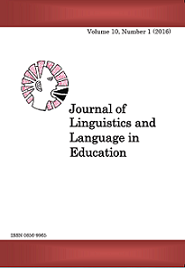A Morphophonological Analysis of Imbrication in Kuria
Abstract
This paper describes imbrication in the Kuria language. This is a language that is spoken in Kenya and Tanzania. It has a robust agglutinative morphology that is largely regular except for verbs in the perfective tense whose forms undergo some changes resulting in an opaque form. This is the process of imbrication. Although some Bantu languages have forms that undergo imbrication, these are different in each language. The paper sets out to describe, with plenty of examples, how the regular perfective forms in Kuria undergo imbrication and the conditions necessary for imbrication to take place.
Key words: imbrication, perfective, base, root, minimality, regular, irregular
References
Bastin, Y. (1983). La finale €“ IDE et I ' imbrication en Bantou
(Anneles 114) Tervureni: Musée Royal de ' Afrique Centrale.
Chebanne, A. M. (1999). The Imbrication of Suffixes in Setswana.
Paper presented at the Annual Conference on African
Linguistics (24th 1993).
Givón, T. (1970). On Ordered Rules and the Modified Base of
CiBemba Verbs. Journal of African Studies, 29(1): 47 €“54.
Guralnik, D. B. (2004). Webster ' s New World Dictionary (4th ed.).
Indianapolis: Emerald Group Publishing Limited.
Hyman, L. M. (1995). Minimality and the Prosodic Morphology of
CiBemba Imbrication. Journal of African Languages and Linguistics ,16(1): 3 €“39.
Kula, N. C. (2001). Imbrication in Bemba. In E. Hume, N. Smith &
Jeroen va de Weijier (eds.). Surface Syllable Structure and Sequencing. HIL Occasional Papers, 102 €“116.
Mould, M. (1972). On Reconstructing the Modified Base of Bantu
Verbs. Studies in African Linguistics, 3: 107 €“125.
Mutaka, N. & Hyman, L. M. (1990). Syllable and Morpheme
Integrity in Kinande Reduplication. Phonology, 7: 73 €“119.
Ngunga, A. (1998). Imbrication in Ciyao. In I. Middieson &
Hinnebusch (eds.). Language History and Desription in Africa.
Africa World Press Inc.
Downloads
Published
Issue
Section
License
Copyright © by Department of Foreign Languages and Linguistics, University of Dar es Salaam
All rights reserved. No part of this publication may be reproduced or transmitted in any form or by any means, electronic or mechanical, including photocopying, recording, or any information storage or retrieval system, without permission in writing from the publisher, except for short extracts in fair dealing, for research or private study, critical scholarly review or discourse with an acknowledgement.



